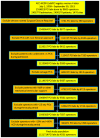Effectiveness of Arterial Closure Devices for Preventing Complications With Percutaneous Coronary Intervention: An Instrumental Variable Analysis
- PMID: 27059685
- PMCID: PMC4832135
- DOI: 10.1161/CIRCINTERVENTIONS.115.003464
Effectiveness of Arterial Closure Devices for Preventing Complications With Percutaneous Coronary Intervention: An Instrumental Variable Analysis
Abstract
Background: Bleeding is associated with poor outcomes after percutaneous coronary intervention (PCI). Although arterial closure devices (ACDs) are widely used in clinical practice, whether they are effective in reducing bleeding complications during transfemoral PCI is uncertain. The objective of this study was to evaluate the effectiveness of ACDs for the prevention of vascular access site complications in patients undergoing transfemoral PCI using an instrumental variable approach.
Methods and results: We performed a retrospective analysis of the CathPCI Registry from 2009 to 2013 at 1470 sites across the United States. Variation in the proportion of ACDs used by each individual physician operator was used as an instrumental variable to address potential confounding. A 2-stage instrumental variable analysis was used as the primary approach. The main outcome measure was vascular access site complications, and nonaccess site bleeding was used as a falsification end point (negative control) to evaluate for potential confounding. A total of 1 053 155 ACDs were used during 2 056 585 PCIs during the study period. The vascular access site complication rate was 1.5%. In the instrumental variable analysis, the use of ACDs was associated with a 0.40% absolute risk reduction in vascular access site complications (95% confidence interval, 0.31-0.42; number needed to treat=250). Absolute differences in nonaccess site bleeding were negligible (risk difference, 0.04%; 95% confidence interval, 0.01-0.07), suggesting acceptable control of confounding in the comparison.
Conclusions: ACDs are associated with a modest reduction in major bleeding after PCI. The number needed to treat with ACDs to prevent 1 major bleeding event is high.
Keywords: bleeding; complications; femoral artery; percutaneous coronary intervention; vascular closure devices.
© 2016 American Heart Association, Inc.
Figures
Similar articles
-
Arterial access-site complications after use of a vascular closure device related to puncture height.BMC Cardiovasc Disord. 2017 Feb 16;17(1):64. doi: 10.1186/s12872-017-0484-7. BMC Cardiovasc Disord. 2017. PMID: 28209184 Free PMC article.
-
Relationship Between Femoral Vascular Closure Devices and Short-Term Mortality From 271 845 Percutaneous Coronary Intervention Procedures Performed in the United Kingdom Between 2006 and 2011: A Propensity Score-Corrected Analysis From the British Cardiovascular Intervention Society.Circ Cardiovasc Interv. 2016 Jun;9(6):e003560. doi: 10.1161/CIRCINTERVENTIONS.116.003560. Circ Cardiovasc Interv. 2016. PMID: 27225421
-
Cost-effectiveness of contemporary vascular closure devices for the prevention of vascular complications after percutaneous coronary interventions in an all-comers PCI population.EuroIntervention. 2014 Jun;10(2):191-7. doi: 10.4244/EIJV10I2A32. EuroIntervention. 2014. PMID: 24952056
-
Safety of transradial access compared to transfemoral access with hemostatic devices (vessel plugs and suture devices) after percutaneous coronary interventions: A systematic review and meta-analysis.Catheter Cardiovasc Interv. 2020 Aug;96(2):285-295. doi: 10.1002/ccd.29061. Epub 2020 Jun 10. Catheter Cardiovasc Interv. 2020. PMID: 32521099
-
Comparison of manual compression and vascular hemostasis devices after coronary angiography or percutaneous coronary intervention through femoral artery access: A meta-analysis of randomized controlled trials.Cardiovasc Revasc Med. 2018 Mar;19(2):151-162. doi: 10.1016/j.carrev.2017.08.009. Epub 2017 Aug 19. Cardiovasc Revasc Med. 2018. PMID: 28941744
Cited by
-
Conscious Sedation Versus General Anesthesia for Transcatheter Aortic Valve Replacement: Variation in Practice and Outcomes.JACC Cardiovasc Interv. 2020 Jun 8;13(11):1277-1287. doi: 10.1016/j.jcin.2020.03.008. JACC Cardiovasc Interv. 2020. PMID: 32499018 Free PMC article.
-
Practical Improvements for Medical Device Evaluation.JAMA. 2017 Jul 25;318(4):332-334. doi: 10.1001/jama.2017.8976. JAMA. 2017. PMID: 28742887 Free PMC article. No abstract available.
-
Association of Physician Variation in Use of Manual Aspiration Thrombectomy With Outcomes Following Primary Percutaneous Coronary Intervention for ST-Elevation Myocardial Infarction: The National Cardiovascular Data Registry CathPCI Registry.JAMA Cardiol. 2019 Feb 1;4(2):110-118. doi: 10.1001/jamacardio.2018.4472. JAMA Cardiol. 2019. PMID: 30624549 Free PMC article.
-
Intravascular imaging during percutaneous coronary intervention: temporal trends and clinical outcomes in the USA.Eur Heart J. 2023 Oct 12;44(38):3845-3855. doi: 10.1093/eurheartj/ehad430. Eur Heart J. 2023. PMID: 37464975 Free PMC article.
-
Use of Chronic Oral Anticoagulation and Associated Outcomes Among Patients Undergoing Percutaneous Coronary Intervention.J Am Heart Assoc. 2016 Oct 17;5(10):e004310. doi: 10.1161/JAHA.116.004310. J Am Heart Assoc. 2016. PMID: 27792650 Free PMC article.
References
-
- Manoukian SV, Feit F, Mehran R, Voeltz MD, Ebrahimi R, Hamon M, Dangas GD, Lincoff AM, White HD, Moses JW, King SB, 3rd, Ohman EM, Stone GW. Impact of major bleeding on 30-day mortality and clinical outcomes in patients with acute coronary syndromes: an analysis from the ACUITY Trial. J Am Coll Cardiol. 2007;49:1362–8. - PubMed
-
- Pinto DS, Stone GW, Shi C, Dunn ES, Reynolds MR, York M, Walczak J, Berezin RH, Mehran R, McLaurin BT, Cox DA, Ohman EM, Lincoff AM, Cohen DJ. Economic evaluation of bivalirudin with or without glycoprotein IIb/IIIa inhibition versus heparin with routine glycoprotein IIb/IIIa inhibition for early invasive management of acute coronary syndromes. J Am Coll Cardiol. 2008;52:1758–68. - PubMed
-
- Jolly SS, Yusuf S, Cairns J, Niemela K, Xavier D, Widimsky P, Budaj A, Niemela M, Valentin V, Lewis BS, Avezum A, Steg PG, Rao SV, Gao P, Afzal R, Joyner CD, Chrolavicius S, Mehta SR. Radial versus femoral access for coronary angiography and intervention in patients with acute coronary syndromes (RIVAL): a randomised, parallel group, multicentre trial. Lancet. 2011;377:1409–20. - PubMed
-
- Daugherty SL, Thompson LE, Kim S, Rao SV, Subherwal S, Tsai TT, Messenger JC, Masoudi FA. Patterns of use and comparative effectiveness of bleeding avoidance strategies in men and women following percutaneous coronary interventions: an observational study from the National Cardiovascular Data Registry. J Am Coll Cardiol. 2013;61:2070–8. - PMC - PubMed
Publication types
MeSH terms
Grants and funding
LinkOut - more resources
Full Text Sources
Other Literature Sources
Medical
Miscellaneous



